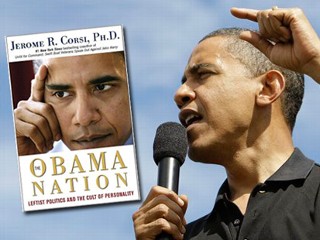Is it getting ready to be ugly at the Democratic National Convention? There are some crazy reports coming out of main stream media and the blogosphere. Take for instance, Stephen ohlemacher at the Associated Press is reporting that Hillary Clinton supporters "aren't buying the unity theme planned for the Democratic National Convention." He writes, "One group intends to paper the city with fliers, promote a video detailing what they contend were irregularities in the nominating process and unleash bloggers to give their take on the proceedings. Another group has purchased newspaper advertisements demanding that Clinton be included in a roll-call vote for the nomination. Meanwhile, the Obama Nation of Barack Obama continues. AAPP: This is looking pretty ugly to me. and I'm not the only one wondering what the hell is going on with Hillary and Bill trying to upstage Obama at the convention. Check out comments from Democratic National Committee member and former Texas Democratic Party Chairman Bob Slagle in the Dallas Morning News, who said he'd write to fellow Clinton delegates and urge them not to push a legitimate roll call vote. "They may have it choreographed where there is some stage play," Mr. Slagle said. "She could go up there and give a flowery speech and then ask her supporters to vote for Obama. I don't know why she would want a roll call vote and then go down in flames." AAPP says: Yes, the Obama campaign (which now controls the Democratic National Committee) has agreed to allow Sen. Hillary Clinton's name to be placed in nomination. To this AAPP this is more than just symbolic as some major news media outlets are trying to play it. This is a divisive effort on the part of Bill and Hillary Clinton to negatively impact on the campaign of Barack Obama. Can you imagine the impact of seeing black delegates having to cast votes for Hillary Clinton Vs. Barack Obama in the state delegate/ballot count? Black delegates being placed in the position of voting for Hillary who is suppose to lose the nomination? Black delegates have already taken a beating at home for supporting Hillary. Hillary has limited grass root support in black communities across America. But then again she must be playing to win the nomination away from Obama even at this 24th hour. More HERE |
Friday, August 15, 2008
Is Hillary Clinton Still Trying to Steal The Nomination?
Posted by
AAPP
at
5:57 PM
0
comments
![]()
Labels: Barack Obama vs Hillary and Bill Clinton, Concede Now Hillary
RIP: Hobie Beaufort 1993-2008
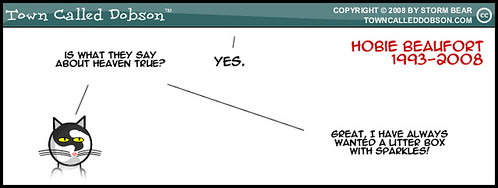 click to enlarge Just before the Fourth of July, in 1993, a young six year old boy knocked on my apartment door. When I answered I saw a panicked lad, who just happened to have a big impetigo breakout all over his face.
So I followed the kid down the stairs and there was a nervous mother with her freshly born kittens - all mewing. I told the kid not to touch the cats, that the mother will take care of them. He finally went home and I later went back down the check on the mother. In that few hours of time, the mother had moved the brood off somewhere. I walked around the back yard and in the woods and I found one kitten abandoned and covered in flies. I turned around to get a shovel and a twig snapped under my foot. The sound awoke the kitten and it started screaming. MEW! MEW! MEW! I chased away the flies and picked the kitten up and headed towards the apartment. My wife and I jumped in the truck and headed towards the vet. They told us not to get our hopes up, that abandoned kittens rarely live long. And of course we ignored everything the vet said and stocked up on syringes and kitten formula. FOR TWO WEEKS, we got up every two hours to feed the kitten. My wife swears she got up half the time at night to feed the kitten, but my recollection is she got up to push me out of the bed to feed the kitten... details. The kitten graduated from kitten formula to some sort of kitten gruel, she would stand in the bowl - all four legs, to eat the gruel. Not too long after that she moved on to hard food. That is how we came to have Hobie Beaufort in our home. As Hobie got older, her name got longer. During the Million Man March, Hobie added a Muslim name to become Hobie Bobozz Beaufort. This continued until her named ended up as... Hobie Bobozz Muhammad Baggins Wendigo Beaufort She even had a theme song that was sung to the tune "Tubthumping" By Chumbawamba. Here is an excerpt...
Hobie was decently well-traveled for a cat. She rode with me to the depths of Virginia when I was on a lotto ticket run. She would poke her head under my left arm and watch the traffic go by. Passing kids always went ballistic when they saw Hobie staring at them. She also went all the way to Ocean Isle, NC for a little beach visit. While in the beach house, she would sit at the top of the stairs and peer down at all of us mortals. Hobie also had her share of health concerns. She had a heart attack one morning and she was saved by Dr. Herman of Shallowford Animal Hospital in Lewisville, NC. Dr. Radford of Winston Salem, NC also kept Hobie healthy with her holistic health care regimens. They together gave us five more years of Hobiness filled with Bobozzitude. After Hobie's heart attack, we were always on the lookout for abnormal behavior to alert us as to when to whisk her to the vet. One early, early morning, Hobie fell out of bed and seemed a bit dazed. So we rushed her around to FOUR VETS until we found one that was open. So if we did that just when Hobie was coming out of a bad dream, you can imagine all the trips to the vet Hobie suffered through. Yesterday was a different story. Hobie was in distress and couldn't walk. We rushed her to Dr. Herman's office and she said it looked like she threw a clot and we need to rush her to the emergency vet a few miles away. Her conditioned worsened, her lungs were filling with fluid and her heavy breathing had a sloshy gurgling sound. The news from the emergency vet was not any better. The vet concluded that it was indeed a clot and Hobie was in deep distress - on oxygen as she was slowly drowning in her own fluids. Hobie was put to sleep minutes later. I have decided to retire the Hobie Beaufort character from Dobson - it is just too painful to put her in another strip. Her memorial strip will be her last.  |
Has Bush Toppled Off the Wagon?
Appearing at The Jaundiced Eye, the Independent Bloggers' Alliance, and My Left Wing. 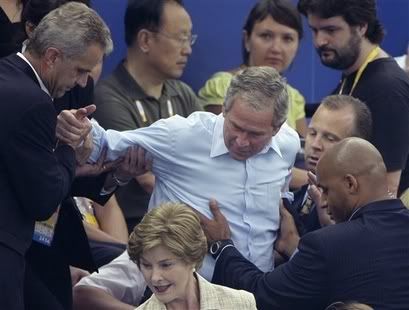 There has been a good deal of blogospheric chatter about the public antics of the leader of the free world, in full view of cameras, at the olympics. Much of it speculation about whether or not he's drunk off his ass. The folks at BuzzFlash have been digging a little deeper into the trash heap, for a bit of the back-story. The tabloids have been dishing dirt about a potential split between George and Laura. Reason: his drinking. If the Edwards scandal has taught us anything, it's that tabloids may traffic in sleaze, but their sleazy reporting is also often true. Now, travel with us a little farther down the road on this one, because you only need look at Bush's inappropriate, juvenile, and just plain bizarre behavior during his Olympic trip to wonder if indeed he has been hitting the sauce again (of which there has been potential evidence in the past, including a bruised face and that strange pretzel and "near beer" choking incident, among others). Now, I don't watch the olympics. I have better cures for the occasional insomnia. But, I've apparently been missing something of a show. Some of this seems a little undignified to me.  It certainly demonstrates a lack of presidential decorum, whether or not it proves drunkenness. But, for those of us who have long been concerned about having a dry drunk in office, it sends up something of a red flag. |
Thursday, August 14, 2008
Black History: Montgomery Bus Boycott
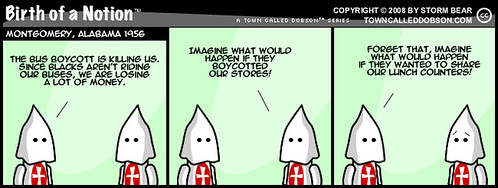 click to enlarge From Wikipedia: The Montgomery Bus Boycott was a political and social protest campaign started in 1955 in Montgomery, Alabama, intended to oppose the city's policy of racial segregation on its public transit system. The ensuing struggle lasted from December 1, 1955, to December 20, 1956, and led to a United States Supreme Court decision that declared the Alabama and Montgomery laws requiring segregated buses unconstitutional. Under the system of segregation used on Montgomery buses, white people who boarded the bus took seats in the front rows, filling the bus toward the back. Black people who boarded the bus took seats in the back rows, filling the bus toward the front. Eventually, the two sections would meet, and the bus would be full. If another black person boarded the bus, he was required to stand. If another white person boarded the bus, then everyone in the black row nearest the front had to get up and stand, so that a new row for white people could be created. Rosa Parks was sitting in the front-most row for black people. When a white man boarded the bus, everyone in her row was expected to move back to create a new row for the whites. While all of the others in her row complied, Rosa refused, and was arrested for failing to obey the driver's seat assignments, as city ordinance did not explicitly mandate segregation, but gave the bus driver authority to assign seats. Rosa Parks was born on February 4, 1913 in Tuskegee, Alabama. She was a seamstress by profession and secretary for the Montgomery chapter of the NAACP. Shortly before being arrested on December 1, 1955, she had completed a course in "Race Relations" at the Highlander Folk School in Tennessee where nonviolent civil-disobedience had been discussed as a tactic. The boycott was triggered by her arrest--when she was charged for violating racial segregation laws in Montgomery after refusing to give up her bus seat to a white man. She was sitting in the fifth row (the first row that blacks could occupy), along with three other blacks. Soon, all of the first four rows were filled up, and a white man walked on. Since blacks and whites could not be in the same row, the bus driver insisted for all of the blacks to move. The other three blacks complied, but Parks refused and was dragged off of the bus. Her arrest immediately followed. When found guilty on December 15, Parks was fined $10 plus a court cost of $4, but she appealed. As a result, Rosa Parks is considered one of the pioneers of the civil rights movement. Some kind of action against segregation had been in the works for some time before Rosa Parks' arrest, under the leadership of E. D. Nixon, president of the local NAACP chapter and a member of the Brotherhood of Sleeping Car Porters. Nixon intended that her arrest be a test case to allow Montgomery's black citizens to challenge segregation on the city's public buses. With this goal, community leaders had been waiting for the right person to be arrested, a person who would anger the black community into action, who would agree to test the segregation laws in court, and who, most importantly, was "above reproach." When fifteen year old Claudette Colvin was arrested early in 1955 for refusing to give up her seat to a white man, E.D. Nixon thought he had found the perfect person, but the teenager turned out to be pregnant. Nixon later explained, "I had to be sure that I had somebody I could win with." Parks, however, was a good candidate because of her employment and marital status, along with her good standing in the community. Between Parks' arrest and trial, Nixon organized a meeting of local ministers at the church of Rev. Martin Luther King, Jr. Though Nixon could not attend the meeting because of his work schedule, he arranged that no election of a leader for the proposed boycott would take place until his return. When he returned he caucused with Ralph Abernathy and Rev. E.N. French to name the association to lead the boycott (they selected the 'Montgomery Improvement Association' ("MIA")) to the city, and select Rev. King (Nixon's choice) to lead the boycott. Nixon wanted King to lead the boycott because the young minister was new to Montgomery and the city fathers had not had time to intimidate him. At a subsequent, larger meeting of ministers, Nixon's agenda was threatened by the clergy men's reluctance to support the campaign. Nixon was indignant, pointing out that their poor congregations worked to put money into the collection plates so these ministers could live well, and when those congregations needed the clergy to stand up for them, those comfortable ministers refused to do so. Nixon threatened to reveal the ministers' cowardice to the black community, and Rev. King spoke up, denying he was afraid to support the boycott. King agreed to lead the MIA, and Nixon was elected its treasurer. On the night of Rosa Parks's arrest, Jo Ann Robinson, head of the Women's Political Council printed and circulated a flyer throughout Montgomery's black community which read as follows:
The next morning at a church meeting led by the new MIA head, Rev. King, a citywide boycott of public transit was proposed to demand a fixed dividing line for the segregated sections of the buses. Such a line would have meant that if the white section of the bus was oversubscribed, whites would have to stand; blacks would not be forced to remit their seats to whites. This demand was a compromise for the leaders of the boycott who believed that the city of Montgomery would be more likely to accept rather than demand for a full integration of the buses. In this respect, the MIA leadership followed the pattern of earlier boycott campaigns in the Deep South during the 1950s. A prime example was the successful boycott a few years earlier of service stations in Mississippi for refusing to provide restrooms for blacks. The organizer of that campaign, T.R.M. Howard of the Regional Council of Negro Leadership, had spoken in Montgomery as King's guest at the Dexter Avenue Baptist Church only days before Parks's arrest. This demand was to be supplemented by a requirement that all bus passengers receive courteous treatment by bus operators, be seated on a first-come, first-served basis, and blacks be employed as bus drivers. The proposal was passed, and the boycott was to commence the following Monday. To publicize the impending boycott it was advertised at black churches throughout Montgomery the following Sunday. On Saturday, December 3, it was evident that the black community would support the boycott, and very few blacks rode the buses that day. That night a mass meeting was held to determine if the protest would continue, and attendees enthusiastically agreed. The boycott proved extremely effective, with enough riders lost to the city transit system to cause serious economic distress. Martin Luther King later wrote "[a] miracle had taken place." Instead of riding buses, boycotters organized a system of carpools, with car owners volunteering their vehicles or themselves driving people to various destinations. Some white housewives also drove their black domestic servants to work, although it is unclear to what extent this was based on sympathy with the boycott, versus the desire to have their staff present and working. When the city pressured local insurance companies to stop insuring cars used in the carpools, the boycott leaders arranged policies with Lloyd's of London. Black taxi drivers charged ten cents per ride, a fare equal to the cost to ride the bus, in support of the boycott. When word of this reached city officials on December 8, 1955, the order went out to fine any cab driver who charged a rider less than 45 cents. In addition to using private motor vehicles, some people used non-motorized means to get around, such as cycling, walking, or even riding mules or driving horse-drawn buggies. Some people also hitchhiked. During rush hours, sidewalks were often crowded. As the buses received extremely few, if any, passengers, their officials asked the City Commission to allow stopping service to black communities. Across the nation, black churches raised money to support the boycott and collected new and slightly used shoes to replace the tattered footwear of Montgomery's black citizens, many of whom walked everywhere rather than ride the buses and submit to Jim Crow laws. In response, opposing whites swelled the ranks of the White Citizens' Council, the membership of which doubled during the course of the boycott. The councils sometimes resorted to violence: Martin Luther King's and Ralph Abernathy's houses were firebombed, as were four black Baptist churches. Boycotters were often physically attacked. Under a 1921 ordinance, 156 protesters were arrested for "hindering" a bus, including King. He was ordered to pay a $500 fine or serve 386 days in jail. He ended up spending 2 weeks in prison. The move backfired by bringing national attention to the protest. King commented on the arrest by saying: "I was proud of my crime. It was the crime of joining my people in a nonviolent protest against injustice." Pressure increased across the country and on June 4, 1956, the federal district court ruled that Alabama's racial segregation laws for buses were unconstitutional. However, an appeal kept the segregation intact, and the boycott continued until, finally, on November 13, 1956, the Supreme Court upheld the lower court's ruling. This victory led to a city ordinance that allowed black bus passengers to sit virtually anywhere they wanted, and the boycott officially ended December 20, 1956. The boycott of the buses had lasted for 381 days. Martin Luther King Jr. capped off the victory with a magnanimous speech to encourage acceptance of the decision. The boycott resulted in the U.S. civil rights movement receiving one of its first victories and gave Martin Luther King Jr. the national attention that made him one of the prime leaders of the cause. Birth Of A Notion Disclaimer:
BIRTH OF A NOTION WALLPAPER is now available for your computer. Click here. |
Posted by
Storm Bear
at
11:16 AM
0
comments
![]()
Labels: black history, cartoons, comics, humor, politics, webcomics
Monday, August 11, 2008
Black History: Loving vs. Virginia
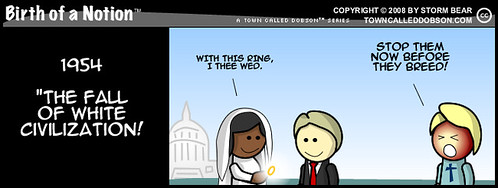 click to enlarge Loving v. Virginia, 388 U.S. 1 (1967), was a landmark civil rights case in which the United States Supreme Court declared Virginia's anti-miscegenation statute, the "Racial Integrity Act of 1924", unconstitutional, thereby overturning Pace v. Alabama (1883) and ending all race-based legal restrictions on marriage in the United States. The plaintiffs, Mildred Loving (nee Mildred Delores Jeter, a woman of African and Rappahannock Native American descent, 1939 – May 2, 2008) and Richard Perry Loving (a white man, October 29, 1933 – June 1975), were residents of the Commonwealth of Virginia who had been married in June 1958 in the District of Columbia, having left Virginia to evade the Racial Integrity Act, a state law banning marriages between any white person and any non-white person. Upon their return to Caroline County, Virginia, they were charged with violation of the ban. Specifically, they were charged under Section 20-58 of the Virginia Code, which prohibited interracial couples from being married out of state and then returning to Virginia, and Section 20-59, which classified "miscegenation" as a felony punishable by a prison sentence of between one and five years. On January 6, 1959, the Lovings pleaded guilty and were sentenced to one year in prison, with the sentence suspended for 25 years on condition that the couple leave the state of Virginia. The trial judge in the case, Leon Bazile, echoing Johann Friedrich Blumenbach's 18th-century interpretation of race, proclaimed that
The Lovings moved to the District of Columbia, and on November 6, 1963 the American Civil Liberties Union filed a motion on their behalf in the state trial court to vacate the judgment and set aside the sentence on the grounds that the violated statutes ran counter to the Fourteenth Amendment. This set in motion a series of lawsuits which ultimately reached the Supreme Court. On October 28, 1964, after their motion still had not been decided, the Lovings began a class action suit in the U.S District Court for the Eastern District of Virginia. On January 22, 1965, the three-judge district court decided to allow the Lovings to present their constitutional claims to the Virginia Supreme Court of Appeals. Virginia Supreme Court Justice Harry L. Carrico (later Chief Justice of the Court) wrote an opinion for the court upholding the constitutionality of the anti-miscegenation statutes and, after modifying the sentence, affirmed the criminal convictions. Ignoring United States Supreme Court precedent, Carrico cited as authority the Virginia Supreme Court's own decision in Naim v. Naim (1955), and also argued that the case at hand was not a violation of the Fourteenth Amendment Equal Protection Clause because both the white and the non-white spouse were punished equally for the "crime" of "miscegenation", an argument similar to that made by the United States Supreme Court in 1883 in Pace v. Alabama. In 1966, the Presbyterian Church took a strong stand stating that they do not condemn or prohibit interracial marriages. The church found "no theological grounds for condemning or prohibiting marriage between consenting adults merely because of racial origin". In that same year, the Unitarian Universalist Association declared that "laws which prohibit, inhibit or hamper marriage or cohabitation between persons because of different races, religions, or national origins should be nullified or repealed." Months before the Supreme Court ruling on Loving v. Virginia the Roman Catholic Church joined the movement, supporting interracial couples in their struggle for recognition of their right to marriage. Prior to Loving v. Virginia there were several cases on the subject of race mixing cases. In Pace v. Alabama (1883) the Supreme Court ruled that the conviction of an Alabama couple for interracial sex, affirmed on appeal by the Alabama Supreme Court, did not violate the Fourteenth Amendment. Interracial extramarital sex was deemed a felony, whereas extramarital sex ("adultery or fornication") was only a misdemeanor. On appeal, the United States Supreme Court ruled that the criminalization of interracial sex was not a violation of the equal protection clause because whites and non-whites were punished in equal measure for the offense of engaging in interracial sex. The court did not need to affirm the constitutionality of the ban on interracial marriage that was also part of Alabama's anti-miscegenation law, since the plaintiff, Mr. Pace, had chosen not to appeal that section of the law. After Pace v. Alabama, the constitutionality of anti-miscegenation laws banning marriage and sex between whites and non-whites remained unchallenged until the 1920s. In Kirby v. Kirby (1921), Mr. Kirby asked the state of Arizona for an annulment of his marriage. He charged that his marriage was invalid because his wife was of ‘negro’ descent, thus violating the state's anti-miscegenation law. The Arizona Supreme Court judged Mrs. Kirby’s race by observing her physical characteristics and determined that she was of mixed race, thereby granting Mr. Kirby’s annulment. In the Monks case (Estate of Monks, 4. Civ. 2835, Records of California Court of Appeals, Fourth district), the Superior Court of San Diego County in 1939 decided to invalidate the marriage of Marie Antoinette and Allan Monks because she was deemed to have "one eight negro blood". The court case involved a legal challenge over the conflicting wills that had been left by the late Allan Monks, an old one in favor of a friend named Ida Lee and a newer one in favor of his wife. Lee's lawyers charged that the marriage of the Monkses, which had taken place in Arizona, was invalid under Arizona state law because Marie Antoinette was "a Negro" and Alan had been white. Despite conflicting testimony by various expert witnesses, the judge defined Mrs. Monks' race by relying on the anatomical "expertise" of a surgeon. The judge ignored the arguments of an anthropologist and a biologist that it was impossible to tell a person's race from physical characteristics. Monks then challenged the Arizona anti-miscegenation law itself, taking her case to the California Court of Appeals, Fourth District. Monks's lawyers pointed out that the anti-miscegenation law effectively prohibited Monks as a mixed-race person from marrying anyone: "As such, she is prohibited from marrying a negro or any descendant of a negro, a Mongolian or an Indian, a Malay or a Hindu, or any descendants of any of them. Likewise ... as a descendant of a negro she is prohibited from marrying a Caucasian or a descendant of a Caucasian...." The Arizona anti-miscegenation statute thus prohibited Monks from contracting a valid marriage in Arizona, and was therefore an unconstitutional constraint on her liberty. The court, however, dismissed this argument as inapplicable, since the case presented involved not two mixed-race spouses but a mixed-race and a white spouse: "Under the facts presented the appellant does not have the benefit of assailing the validity of the statute." Dismissing Monks's appeal in 1942, the United States Supreme Court refused to reopen the issue. The turning point came with Perez v. Sharp (1948), also known as Perez v. Lippold. In Perez, the Supreme Court of California recognized that interracial bans on marriage violated the Fourteenth Amendment of the Federal Constitution. The U.S. Supreme Court overturned the convictions in a unanimous decision, dismissing the Commonwealth of Virginia's argument that a law forbidding both white and black persons from marrying persons of another race, and providing identical penalties to white and black violators, could not be construed as racially discriminatory. The court ruled that Virginia's anti-miscegenation statute violated both the Due Process Clause and the Equal Protection Clause of the Fourteenth Amendment. In its decision, the court wrote:
The Supreme Court concluded that anti-miscegenation laws were racist and had been enacted to perpetuate white supremacy:
Despite this Supreme Court ruling, such laws remained on the books, although unenforced, in several states until 2000, when Alabama became the last state to repeal its law against mixed-race marriage. The definition of a marriage and what constitutes a family was reconsidered by society after the decision of Loving v. Virginia. Following Loving v. Virginia, The Changing Nature of Interracial Marriage in Georgia: A Research Note states "there was a 448 per cent increase in the number of interracial marriages. These numbers are only from the state of Georgia after the Supreme Court ruling, but the numbers and percentages only continued to increase across the United States. However, interracial couples still had to overcome many fears of possibly losing respect from friends, family, and the community. Some activists believe that the Loving ruling will eventually aid the marriage equality movement for same-sex partnerships, if courts allow the Equal Protection Clause to be used. F.C. Decoste states, "If the only arguments against same sex marriage are sectarian, then opposing the legalization of same sex marriage is invidious in a fashion no different from supporting anti miscegenation laws". These activists maintain that miscegenation laws are to interracial marriage, as sodomy laws are to homosexual rights and that sodomy laws were enacted in order to maintain traditional sex roles that have become part of American society. Opponents point out that the United States Supreme Court in the case of Baker v. Nelson, decided just a few years after the Loving decision, summarily affirmed that traditional marriage laws do not violate the Constitution of the United States. On June 12, 2007, Mildred Loving issued a rare public statement prepared for delivery on the 40th anniversary of the Loving v. Virginia decision of the US Supreme Court, which commented on same-sex marriage. The concluding paragraphs of her statement read as follows:
Birth Of A Notion Disclaimer:
BIRTH OF A NOTION WALLPAPER is now available for your computer. Click here. |
Sunday, August 10, 2008
Taser Bracelets coming to an Airport near you?
The technology isn't new -- cops and security guards have been using it for years in tasers. What's new is the marketing approach. Lamperd is hawking the EMD bracelet as the ideal tool for fighting terrorists intent on taking over an airplane. And they're doing so with a blatantly exploitive promotional video. You can watch the five minute video, which has gotten more than 33,000 hits at YouTube." You see the website FreeMarketNews.com is reporting on this situation and writes, "A senior government official with the U.S. Department of Homeland Security (DHS) has expressed great interest in a so-called safety bracelet that would serve as a stun device, similar to that of a police Taser®. According to this promotional video found at the Lamperd Less Lethal website, the bracelet would be worn by all airline passengers."This bracelet would: • take the place of an airline boarding pass • contain personal information about the traveler • be able to monitor the whereabouts of each passenger and his/her luggage • shock the wearer on command, completely immobilizing him/her for several minutes More HERE Click Here For The Full Story Also check out Wired: How About Taser Bracelets For Passengers? |
Fair, Balanced, All Edwards, All the Time
Appearing at The Jaundiced Eye, the Independent Bloggers' Alliance, and My Left Wing. Now I would be the last person to say that the Edwards affair is not news. In fact, I've pretty consistently argued that it is news. But this is positively surreal. I think my favorite part is where Erbe is explaining the political and national security implications of the Russia/Georgia war, as they show endless video of John and Elizabeth Edwards and Rielle Hunter. |








